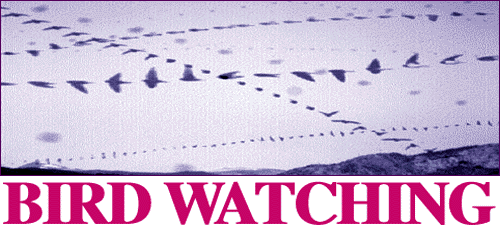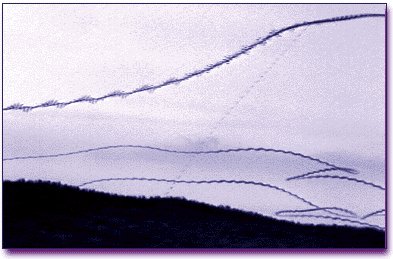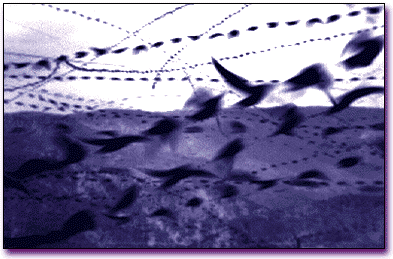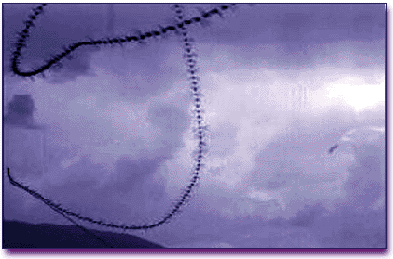 A New Way To Look At An Old Pastime By Glen Southworth
Remember the first time you looked through a microscope? There was a whole new world that you didn't know existed. Perhaps you spent hours after school, examining things you had brought from home— like feathers, dead insects, dog hair, sand— or a host of every day items that might have shown you a fascinating and unsuspected world.
Turning the microscope around leads us to the telescope and, more conveniently, the binocular; a staple ingredient of bird watching. Optical magnification allows us to see and appreciate the characteristics and beauties of these delicate creatures and, when combined with film or a video camera, allows us to record images for future enjoyment and sharing with others. As an enhancement, a microphone and tape recorder may be used to capture
songs or other sounds relevant to an expedition.
Have you ever had the delightful experience of laying on the grass during a warm summer day and looking up at a sky full of soft white clouds? Perhaps you were lucky, and a few swallows skimmed by. You wondered what it would be like to visualize the flight paths of these graceful birds.
Let's imagine that you have magically acquired a second mode of eyesight. First, you still have the ordinary kind where persistence of vision lasts only a fraction of a second. Second, you've acquired a new way of looking at the world, where images can last for minutes or hours. These images continually update without "washing out," as would be the case with a photographic time exposure. (Don't move your head or blink while you're doing this, as it might blur or distort the picture.)
Let technology substitute for imagination. Use a television camera to look at the sky, and watch what's going on with a TV monitor. We're no longer restricted to those nice summer days, but can be puttering around the house, or even be at work if you have a window and a view of the sky. Add a telephoto lens to the camera for additional flexibility, and a video cassette recorder if you don't want to miss anything.
Whoa! How about that second way of looking at the world? Technology comes to the rescue in the form of a small gray box that easily connects between the TV camera and the monitor. Start it up and the TV screen shows an image that looks like an ordinary picture. Flip a switch and the image is frozen, just as if you had a conventional "Frame-Grabber." Go back to start, flip another switch and the magic starts to happen! The picture once again seems frozen, but now changes are added to the original scene, and bird watching changes from seeing tiny little dots moving across the sky into viewing actual patterns of flight.
 Our first illustration, BIRD (above), is an example of the procedure described above. It's an off-screen view of a ten minute video, "time exposure," made from an office window in a rural area outside of Boulder, Colorado. The screen showed a clear sky when the exposure was started, but sometime during the following few minutes a bird, probably a Sparrow Hawk on a hunting expedition, entered the camera's viewing area on the left hand side. It flew across the field of view creating the top trace (partially showing the beating pattern of the of the wings) until leveling off and perhaps coasting, as indicated at the upper right hand side of the image. The bottom two traces show birds, or possibly the same bird, entering on the right hand side of the screen, circling briefly, and disappearing at the left. The operator of the system, being busy with other matters, finally glanced at the screen and decided to "save" this particular image.
 The next example is a picture made on a warm summer afternoon, from the same location, but with the camera pointed towards the mountains. Exposure was probably on the order of two hours (I think the operator went to sleep!). It shows a sky full of birds, both near and far. Note the blurring, particularly of the birds close by. This is due to the use of an older TV camera which essentially accumulated each separate original image for one thirtieth of a second, thus distorting moving objects. A third image, seen in the heading of this article, shows the effect of using a newer video camera, with an electronic shutter set to one thousandth of a second. Wing movement is clearly observable, but vertical resolution is cut in half because the image capture rate is now one sixtieth of a second. A contemporary camera designed for "Machine Vision" or laboratory use would presumably improve matters by using a non-interlaced thirty frame per second format. The gray box may be used for looking at things beside birds. The same technique has been successfully used to reveal landing patterns of planes at a nearby airport. Another bit of summertime entertainment may be capturing lightning strikes. Just use a normal one thirtieth second exposure, stop down the camera lens so a strike won't overload your system, and go do something else. Glance at the monitor occasionally and save something you particularly like. or you may end up with a confusing composite image similar to our earlier bird picture. The Gray Box The gray box, technically known as a Video Peak Store, has a wide range of applications, but is somewhat expensive for home use. A basic system: camera, lens, Peak Store, and TV monitor will probably cost around five thousand dollars and up, depending on the quality of components selected. A useful accessory is a computer, with frame grabber card, which will allow storage of time exposures for later viewing. A word of caution— don't go to your local photography store for a Video Peak Store. Although this device has been in existence for over ten years and is still being manufactured, there are probably less than two hundred in use throughout the world, mostly in industrial and research applications as well as teaching, medical, and artistic uses. Finally, you don't have to be limited to looking out of a window. A camcorder will work nicely in the field or nearly anyplace else and, when you get back home, the tape may be played back through the Video Peak Store to make time exposures of selected segments. A word of caution: use a tripod mount, as the camera needs to be held absolutely steady while recording in order to prevent distortion due to camera movement itself.
 For more detailed explanations of this technique, see Robert R. Cadmus, Jr., "A video technique to facilitate the visualization of physical phenomena," American Journal of Physics, pp. 397-399, April 1990.
Editor's Note: We have seen similar techniques applied to a standard 35 mm camera where the shutter has been left open for several minutes. The result is not as dramatic and the images are often blurred. However, a reader suggested that he has received similar results to those shown here by photographing time lapse images through the rotating blades of an old window fan. The blades actually act as a shutter, allowing moving images to be frozen in strobe-like fashion. With some experimentation and a little ingenuity, you too can see the world in different and surprising ways. Good luck and please share your results with us.
|
If you have a suggestion or a photo to submit, send it to:
Editor/viewzone.com
myristicin@hotmail.com